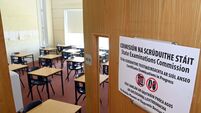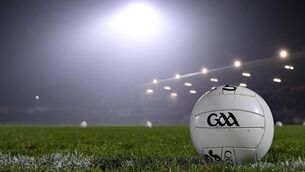Maths frowns 'turned upside down' with Paper 2 but Junior Cert science under fire from teachers

Eoin Quinn and Emma Murphy from St. Brigid’s College, Loughrea Co. Galway reviewing their Leaving Cert paper. Picture: Hany Marzouk
Leaving Cert maths this morning proved to be much more approachable after a stressful start on Friday afternoon with paper 1, while an “open-ended” question about a brown bread sandwich has drawn the ire of science teachers.
The State exams continued this Monday morning with Leaving Cert maths and Junior Cycle science.
Maths paper 1, examined on Friday evening, proved to be a very difficult exam experience for many students across the country, with many parents commenting over the weekend about the stress it caused their children.
“The State Examinations Commission needs to look at this this and think about the fact that it’s the last exam on a Friday and it’s a very long weekend for students and parents to be worried,” said Brendan O’Sullivan, subject spokesperson with the Teachers’ Union of Ireland (TUI).
“We’re not saying that everything has to be familiar and route, but at least keep in mind there are people here who didn’t have the experience of the Junior Cycle exam.”
“It’ll be the same next year so try and bring those candidates with you. We’re almost expecting there to be some issue always with maths, and it doesn’t have to be that way.”
Traditionally, the higher level maths paper 2 would be less popular with students than paper 1, he added.
"But this year that trend is reversed.”
“I’d say both levels will be much happier with paper 2 than they were with paper 1 this time around,” Mr. O’Sullivan added.
“The higher-level paper was much more approachable than what we would have had last Friday. There was a nice start to the questions, which would have calmed the nerves after Friday evening.”
“The ordinary level paper also wasn’t as intense in terms of work and time pressure, they had a bit more of an easier chore in terms of getting through the paper today.”
His message to students: “Don’t panic.”
Students can often fixate on the fact they didn’t answer questions correctly, he added.
"But it was the same all over the country. Everyone focuses on themselves, so everyone only hears their own story. It will be the same across the country, everyone would have found that paper challenging.”
“When the final picture comes out, it will be no better or no worse than any other year.”
The frowns were "very much turned upside down” after paper 2, according to Niall Duddy, subject representative with the Association of Secondary Teachers’ Ireland (ASTI).
The SEC is continuing to blur the lines between paper 1 and paper 2, he added. Calculus appeared on this year’s paper 2, which is a new departure.
"Differentiation also appeared on paper 2, which is usually a paper 1 topic.”
Students he spoke to so far on Monday much preferred paper 2, he added.
"I know that when these things tend to happen in the past, if the first paper is tricky, the second one tend to be much more straightforward. This was no different.”
Studyclix subject spokesperson Stephen Begley said students were given a decent selection of questions on the ordinary level maths paper 2.
“The short questions were mostly direct and concise and covered a single topic each.”
“The long questions had some very nice parts, though maintained a balance of challenge throughout. These context heavy questions were very clear and direct in what they were asking students to do.”
Meanwhile, Junior Cycle science saw a mixed reaction from teachers, who were all united however by a question about digestion.
Shane Curran, a subject representative with the ASTI, said the common-level paper included a few challenging questions to push the higher ability students.
“There was only two calculations on it, which I was a bit surprised about. I thought there would be more. Other than that, there were good graph questions, good experiments.”
However, one question that gave students almost a full page to write about digestion, prompted by a boy biting off a piece of brown bread sandwich, was too “open-ended”.
Michael McGrath, a fellow ASTI subject representative, also took issue with this question.
"They aren’t used to writing script like that. It hasn’t appeared like that, almost a full page of blank lines to fill in what happens after you eat a sandwich.”
“That is tough for an average student. They’ll wonder if the answer wants gastric juice in the stomach, or what happens with the pancreas. It’s open ended.”
Overall, the paper was tough enough, he added.
"Good for high achieving students, but the weaker student will find it challenging.”
Studyclix subject spokesperson Liam Hennelly agreed this question on digestion may have thrown students.
“They were given 22 lines to do an extended piece of writing by describing the processes involved from when bread is put into the mouth to when cells use the energy in the carbohydrate.”













